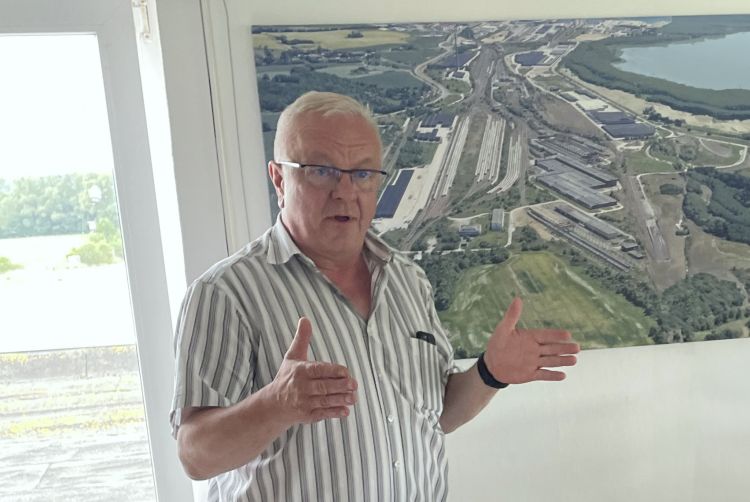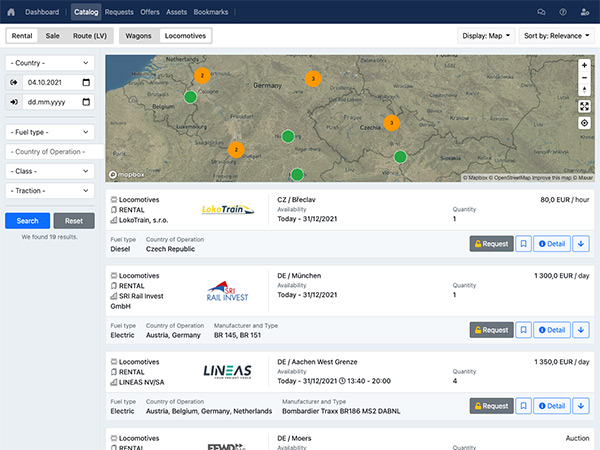RM: Have you noticed any changes in the mix of goods handled in the port over the last year or two?
Tino Gerschler, Baltic Port Rail Mukran GmbH: There have certainly been changes due to the war in Ukraine since February 2022. Until then, in addition to the continuous transport of grain, containers were mainly transported to and from China. The first multimodal transports on the "New Silk Road" went via Mukran as a bypass to the pure land route via Poland/Belarus. These shipments ended in March 2022.
Since then, more grain has been delivered to Mukran by rail for onward transport by ship to Africa and Asia. In addition to these transports, hard coal from Indonesia and Australia has also been transported by rail to Poland via Mukran. There are also occasional project-related cargoes such as ballast, pipes or concrete elements.
RM: What type of cargo dominates rail traffic at the Port of Mukran?
Tino Gerschler, Baltic Port Rail Mukran GmbH: As mentioned above, grain is the dominant rail cargo. In addition, the tracks at Mukran Railway Station are also used to park used and high-value rail vehicles. The existing infrastructure provides various services such as a track pit for underbody work, a track weighbridge or scaffolding for work on the roof of railway vehicles.
RM: As a port, Mukran faces a lot of competition from the surrounding Baltic and North Sea ports. What would you say are the main advantages of the port for railway companies?
Tino Gerschler, Baltic Port Rail Mukran GmbH: On the one hand, the pilot-free access to the port, but also the good rail connection to the European rail network. For example, in the case of the container transports I mentioned earlier, it was possible to run much longer trains than would have been the case via Poland. Another advantage is that, unlike other port locations, the rail network connecting Mukran has enormous capacity reserves. One only has to think of the enormous volumes that were transported via the island of Rügen before the political change. Not to mention the fact that Baltic Port Rail Mukran (BPRM)'s structure allows us to be very flexible in responding to customer needs and that we are always customer-focused.
And the port of Mukran is an important hub for international passenger and freight traffic precisely because of this good rail connection to the hinterland and its geographical proximity to Scandinavia, the CIS, Finland and the Baltic states.
RM: Many last mile shunting service providers are looking at alternative fuels or drives for their locomotives. What is your view on this?
Tino Gerschler, Baltic Port Rail Mukran GmbH: Hybrid locomotives are particularly suitable for shunting operations with frequent starts and stops. As BPRM, we are also looking into their use.
The environmental aspect was also taken into account at Mukran at a very early stage. For example, battery-powered tractors have been used instead of conventional locomotives in certain areas of the site for many decades.
RM: How is the link with China's "Belt and Road" initiative for railways developing?
Tino Gerschler, Baltic Port Rail Mukran GmbH: The Mukran site and, in this context, also the BPRM, have proven in the years 2019 to 2022 that Mukran is a very good bypass for classic Eurasian rail traffic. The customers were much closer to the corresponding terminals in Europe and were therefore able to access the slots there much better and more reliably. Again, the strengths of BPRM mentioned above played a decisive role. There was very close coordination with all the partners involved.
In addition, the Mukran site has traditionally had very good experience with the CIS states, as this young port was originally built for this purpose. In the meantime, of course, the picture has changed and developed, and the portfolio presented in Mukran is much broader.
Overall, I see great potential for Eurasian rail transport in the future, especially on the New Silk Road.
RM: What impact do you think the completion of the Fehmarn Belt Tunnel will have on your short sea shipping and the subsequent rail links?
Tino Gerschler, Baltic Port Rail Mukran GmbH: It has to be said that the biggest break in the Scandinavian rail link occurred in 2000, when the completion of the Öresund Bridge provided a continuous land bridge link to Sweden. At that time, this was clearly felt in the ports of the southern Baltic Sea and also in Mukran. Today, the two shipping companies operating to Scandinavia in Mukran focus more on passenger traffic and I see much less or no influence from the Fehmarnbelt. Even with the completion of the Fehmarnbelt Tunnel, the route via Mukran remains the shortest connection to Scandinavia. I also see advantages in the fact that the high-speed ferry between Mukran and Trelleborg makes the link even more attractive. For this reason, the ferries in Mukran will also be linked to a passenger train service from 2022, which will close the gap between the regional and long-distance services of Deutsche Bahn and the ferries. BPRM is also involved in this project. And the number of passengers is increasing there too. More and more people are also thinking about the environment.
I would like to use a small example to illustrate the advantage of this good passenger connection. Because of the good and fast connection to Copenhagen Airport, more and more local people are choosing to use this airport instead of travelling to Berlin or Hamburg. Simply because you can get to the airport in Copenhagen faster by boat and train than in Berlin or Hamburg, for example.
RM: Do you see growth potential for rail hinterland traffic from the port of Mukran? If so, in which areas?
Tino Gerschler, Baltic Port Rail Mukran GmbH: I see clear opportunities for the Mukran site and, in this context, also for the corresponding hinterland connections. On the one hand, there are enormous capacity reserves at the Mukran site and on the inbound and outbound tracks, where other sites are constantly reaching their limits. I also believe that rail transport will play an increasingly important role in the future. In this context, the growing environmental awareness in society and the corresponding requirements of shippers are of crucial importance. One Norwegian customer, for example, is asking for rail transport from Mukran to Oslo for environmental reasons.
We also believe that we have not yet reached the limit, especially in the agricultural sector. But other bulk goods, which can only be transported to and from the port by rail, will also play a role in the future. In the future, we expect container traffic to return to Mukran, as well as special and project cargo. The corridor concept described by the EU also plays a decisive role here. There is also a lot of room for improvement in passenger traffic, and it is important to develop this potential together with our partners.
The hinterland itself consists mainly of southern and south-eastern Europe and the new German states. But we have also proven our efficiency on several occasions in the economic centres of the old federal states and Western Europe. For example, during the New Silk Road container transports via Mukran, there were regular train connections to Rotterdam, Duisburg, Hamburg, Mannheim, Ulm and Cologne, to name but a few. I see all this as a great potential for the future.
RM: If you could have any wish for your company, what would it be?
Tino Gerschler, Baltic Port Rail Mukran GmbH: It would be a much greater acceptance and appreciation of the railway as a whole. And this must not just be lip service, but must be reflected in action. In my opinion, it would be important, for example, to create a level playing field between road and rail transport. Railway companies, for example, have to bear all the costs arising from the use of railway infrastructure, which in the case of other modes of transport is partly financed from the state budget. This applies both to the parking of rolling stock and to the use of the tracks themselves. The bureaucracy involved in rail transport is also becoming increasingly complex, although it is already disproportionate to that involved in road or inland waterway transport. Don't get me wrong, the lorry is just as much a part of logistics as the train, the barge, the plane, the delivery van and the postman on his bicycle. But each mode should be used in combination according to its strengths.
We need a broad political and social consensus that rail is an important, indispensable and good mode of transport for solving society's logistical challenges in a climate-friendly way. Then we will be able to inspire more people to learn a profession in the railway industry.
As far as rail transport is concerned, I think we can learn a lot from our neighbouring country, Switzerland. There, the railways have a much more positive image in society, both because of the positive image they have among the population and because of the subsidies they receive. Switzerland is definitely a railway country with everything that goes with it.
I wish that Germany could do the same.

